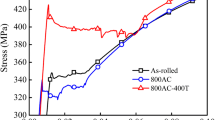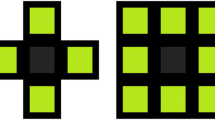Abstract
Austenite–ferrite transformation at different isothermal temperatures in low carbon steel was investigated by a two-dimensional cellular automaton approach, which provides a simple solution for the difficult moving boundary problem that governs the ferrite graun growth. In this paper, a classical model for ferrite nucleation at austenite graun boundaries is adopted, and the kinetics of ferrite graun growth is numerically resolved by coupling carbon diffusion process in austenite and austenite–ferrite (γ–6ga) interface dynamics. The simulated morphology of ferrite grauns shows that the γ–α-interface is stable. In this cellular automaton model, the γ–α-interface mobility and carbon diffusion rate at austenite graun boundaries are assumed to be higher than those in austenite graun interiors. This has influence on the morphology of ferrite grauns. Finally, the modeled ferrite transformation kinetics at different isothermal temperatures is compared with the experiments in the literature and the grid size effects of simulated results are investigated by changing the cell length of cellular automaton model in a set of calculations.
Similar content being viewed by others
References
J.W. Cahn: The kinetics of graun boundary nucleated reactions. Acta Mater. 4, 449 (1956).
C. Zener: Theory of growth of spherical precipitates from solid solution. J. Appl. Phys. 20, 950 (1949).
M. Umemoto, Z.H. Guo, and I. Tamura: Effect of Cooling rate on graun size of ferrite in a carbon steel. Mater. Sci. Technol. 3, 249 (1987).
M. Militzer, R. Pandi, and E.B. Hawbolt: Ferrite nucleation and growth during continuous cooling. Metall. Mater. Trans. A 27A, 1547 (1996).
R.A. Vandermeer: Modelling diffusional growth during austenite decomposition to ferrite in polycrystalline Fe-C alloys. Acta Mater. 38, 2461 (1990).
M. Enomoto and C. Atkinson: Diffusion-controlled growth of disordered interphase boundaries in finite matrix. Acta Mater. 41, 3237 (1993).
M. Kumar, R. Sasikumar, and N.P. Kesavan: Competition between nucleation and early growth of ferrite from austenite— studies using cellular automaton simulations. Acta Mater. 46, 6291 (1998).
L. Zhang, C.B. Zhang, Y.M. Wang, X.H. Liu, and G.D. Wang: Cellular automaton model to simulate nucleation and growth of ferrite grauns for low-carbon steels. J. Mater. Res. 17, 2251 (2002).
L. Zhang, Y.M. Wang, C.B. Zhang, S.Q. Wang, and H.Q. Ye: A cellular automaton model of the transformation from austenite to ferrite in low carbon steels. Modell. Simul. Mater. Sci. Eng. 11, 791 (2003).
L. Zhang, C.B. Zhang, Y.M. Wang, S.Q. Wang, and H.Q. Ye: A cellular automaton investigation of the transformation from austenite to ferrite during continuous cooling. Acta Mater. 51, 5519 (2003).
G.P. Krielaart, J. Sietsma, and S. Zwaag: Ferrite formation in Fe-C alloys during austenite decomposition under nonequilibrium interface conditions. Mater. Sci. Eng. A 237A, 216 (1997).
R. Kobayashi: Modeling and numerical simulations of dendritic crystal growth. Physica D 63, 410 (1993).
A. Karma and W.J. Rappel: Phase-field method for computationally efficient modeling of solidification with arbitrary interface kinetics. Phys. Rev. E 53, 3017 (1996).
A. Karma and W.J. Rappel: Quantitative phase-field modeling of dendritic growth in two and three dimensions. Phys. Rev. E 57, 4323 (1997).
J.A. Warren and W.J. Boettinger: Prediction of dendritic growth and microsegregation patterns in a binary alloy using the phasefield method. Acta Metall. Mater. 43, 689 (1995).
G. Pariser, P. Schaffnit, I. Steinbach, and W. Bleck: Simulation of the _-_-transformation using the phase-field method. Steel Res. 72, 354 (2001).
S. Chen, B. Merriman, S. Osher, and P. Smereka: A simple level set method for solving Stefan problems. J. Comput. Phys. 135, 8 (1997).
S.E. Offerman, N.H. Dijk, J. Sietsma, S. Grigull, E.M. Lauridsen, L. Margulies, H.F. Poulsen, M.T. Rekveldt, and S. Zwaag: Graun nucleation and growth during phase transformation. Science 298, 1003 (2002).
M. Hillert: Solute drag, solute trapping and diffusional dissipation of Gibbs energy. Acta Mater. 47, 4481 (1999).
M. Hillert and L.I. Staffansson: The regular solution model for stoichiometric phases and ionic melts. Acta Chem. Scand. A 24, 3618 (1970).
P.J. Clemm and J.C. Fisher: The influence of graun boundaries on the nucleation of secondary phases. Acta Matell. 3, 70 (1955).
R.G. Kamat, E.B. Hawbolt, L.C. Brown, and J.K. Brimacombe: The principle of additivity and the proeutectoid ferrite transformation. Metall. Trans. A 23A, 2469 (1992).
J.R. Bradley, J.M. Rigsbee, and H.I. Aaronson: Growth kinetics of graun boundary ferrite allotriomorphs in Fe-C alloys. Metall. Trans. A 8A, 323 (1977).
A. Jacot and M. Rappaz: A two-dimensional diffusion model for the prediction of phase transformations: Application to austenitization and homogenization of hypoeutectoid Fe-C steels. Acta Mater. 45, 575 (1997).
P.J. Hurley and P.D. Hodgson: Formation of ultra-fine ferrite in hot rolled strip: potential mechanisms for graun refinement. Mater. Sci. Eng. A A302, 206 (2001).
C.J. Huang, D.Z. Li, and Y.Y. Li: A finite element analysis of straun induced transformation rolling and an experimental study on the graun refinement potential of severe undercooling thermomechanical treatment. Mater. Sci. Eng. A A352, 136 (2003).
D. Raabe and R.C. Becker: Coupling of a crystal plasticity finiteelement model with a probabilistic cellular automaton for simulating primary static recrystallization in aluminium. Modell. Simul. Mater. Sci. Eng. 8, 445 (2000).
Y.J. Lan, D.Z. Li, C.J. Huang, and Y.Y. Li: A cellular automaton model for austenite to ferrite transformation in carbon steel under non-equilibrium interface conditions. Modell. Simul. Mater. Sci. Eng. 12, 719 (2004).
Author information
Authors and Affiliations
Corresponding author
Rights and permissions
About this article
Cite this article
Lan, Y.J., Li, D.Z. & Li, Y.Y. Modeling austenite–ferrite transformation in low carbon steel using the cellular automaton method. Journal of Materials Research 19, 2877–2886 (2004). https://doi.org/10.1557/JMR.2004.0397
Received:
Accepted:
Published:
Issue Date:
DOI: https://doi.org/10.1557/JMR.2004.0397




